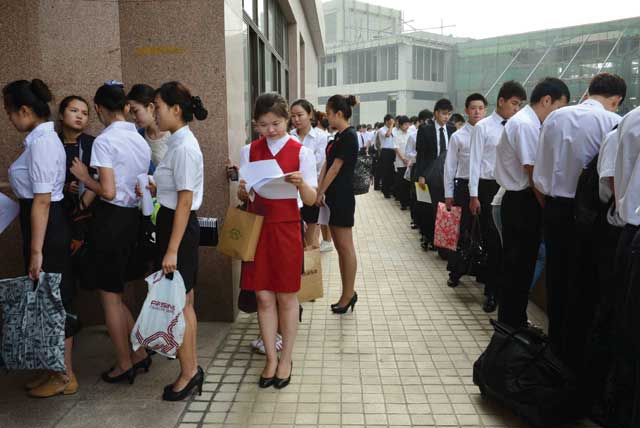China may be recruiting airline captains in their thousands from abroad, but it fully expects to provide the next generation of commanders from its own citizens. The rapid growth of the country's airline sector and the simple reality of the time required to gain the experience needed for the left-hand seat mean that China does not have enough qualified captains to meet its carriers' needs. However, a rapid ramp-up of training provision is ensuring a steady pipeline of young recruits to the right-hand position.
The country will have a requirement for 40,000 pilots by 2015, up from 24,000 in 2010, says the Civil Aviation Administration of China (CAAC). This represents an average annual growth of 11%, or 3,200 pilots for each of the five years. Boeing, looking ahead even further in its 2012 forecast, says that China will need 71,300 pilots and 99,400 technicians up to 2030.
"Some airlines are already experiencing delays and operational interruptions because they don't have enough qualified pilots," says Bob Bellitto, global sales director for Boeing Flight Services. "Surging economies in the region are driving travel demand. Airlines and training providers need new and more engaging ways to fill the pipeline of pilots and technicians for the future."
Civil Aviation Flight University of China (CAFUC), a state-owned pilot training school, has 8,000 full-time students, including cadet pilots. To meet the growing demand from the airlines, it plans to train another 2,000 cadets in the coming years, says the institution.
Privately owned schools and airlines are also trying to fill the gap, both on their own and via joint ventures with foreign companies.
One of these is the Hainan Aviation Academy (HNAA), a joint venture between Hainan Aviation Group, Montpellier-based ESMA Aviation Academy and two investment companies. Hainan Aviation Group is a subsidiary of the HNA Group, which owns Hainan Airlines and Hong Kong Airlines.
The HNAA signed a partnership agreement in March with Singapore's ST Aerospace Academy (STAA) to send 50 of its cadets to undergo high performance aircraft training (HPAT). The cadets will attend a four-week ground school in Yichang, followed by two weeks of flying training in Singapore.
 |
|---|
Want an airline job? Join the queue |
"HPAT serves to help cadet pilots to transit smoothly from handling low-power single-engined and multi-engined aircraft that are used in basic training to multi-turbo-engined aircraft as an intermediary transition to airliners that are operated by commercial airlines," says STAA, a subsidiary of ST Aerospace's.
"STAA's HPAT programme is the only one in the region where all flights are conducted on international air routes," it says. "This has the value-add of allowing cadet pilots to gain valuable real-life experience communicating with air traffic controllers from different countries, as well as flying in varied weather conditions and terrains."
SIMULATION EQUIPMENT
Guangzhou-based China Southern Airlines has partnered with training and simulation equipment and services provider CAE to set up a flying school in Western Australia and a training facility in Zhuhai, Guangdong province.
Its China Southern West Australian Flying College (CSWAFC), located in the state of Western Australia, trains up to 280 cadets selected by the airline on a range of aircraft including the Grob Aircraft G115C trainer and Embraer Phenom 100.
Upon graduation, the cadets proceed to type-rating training at the Zhuhai flight training centre, where the two companies operate a training facility. The facility also provides full-flight simulator training for Airbus, Boeing, Embraer and Sikorsky aircraft.
Flight simulator training is also in demand for type-rated pilots. That is where the likes of Link Simulation & Training, a subsidiary of L-3 Communications, come in. In September, Link sold two Airbus A320 full-flight simulators and a flat-panel trainer to low-cost carrier Spring Airlines. The flat-panel trainer will support procedural training, and decrease the amount of time required in the full-flight simulators, says Link.
CAE is expanding its footprint in China with the sale of two full-flight simulators to flag carrier Air China in January, and another three in August. It also sold a Boeing 737 full-flight simulator to Shandong Airlines.
Boeing, looking at the broader demand for pilots around the world, says that airlines and airframers need to find new ways to ensure that more can be trained at a faster pace.
"Meeting this demand will require airplane manufacturers and the commercial aviation industry to rely more heavily on new digital technology, including online and mobile computing, to meet the learning requirements of a new generation," says Boeing. "The growing diversity of aviation personnel also demands highly qualified, motivated and knowledgeable instructors with cross-cultural and cross-generational skills."
All the latest news, video and images from Zhuhai 2012Source: Flight International























